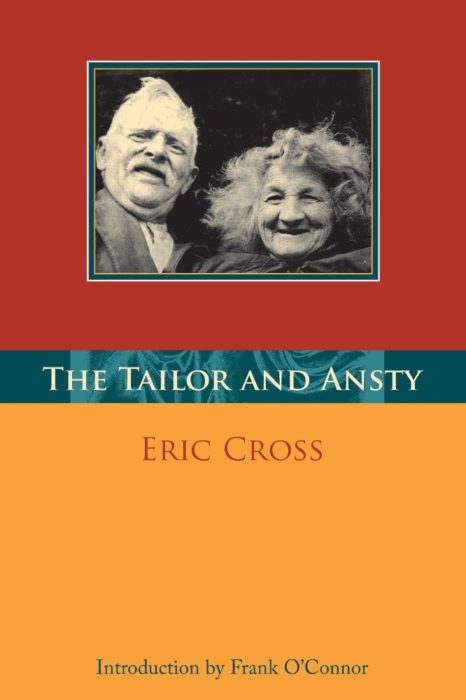
I first came across a copy of The Tailor and Ansty about 25 years ago when I was dossing in the basement of a large house in Bath (England). I’d been visiting my girlfriend for the weekend and the whole event had taken on a surreal nature as we’d broken up during a burlesque circus that was performing there. I ended up stuck, penniless, in a city where I knew no-one and had to spend a full Saturday night there before I could catch the train (and ferry) back to Cork. In the end, I was fortunate enough to find accommodation in the basement of a (very) large house in the centre of town, where a distant acquaintance was flatting.
I found the copy of ‘The Tailor and Ansty’ discarded on the floor of that basement with some old magazines. To be honest, I was a bit surprised to find that particular Irish book there – and a bit curious as well. Over the years, I’d heard it references to it at home but never fully in context, so although I was familiar with the title, I actually had no idea what it was about. I think, at the time, I simply assumed it would be similar to Joyce or Myles na gCopeleen.
With nothing else to do, I picked it up and read it.
The first thing that struck me was the easy readability. Cross had a lovely, nonchalant style that made it a pleasure to read from the very first page.
“In the townland of Garrnapeaka, in the district of Inchigeela, in the parish of Iveleary, in the barony of West Muskerry, in the county of Cork, in the province of Munster” – as he magniloquently styles his address, lives the Tailor.
His small whitewashed cottage, with its acre of ground, stands at the brow of a hill, at the side of a road which winds and climbs into a deep glen of the mountains bordering Cork and Kerry.
If you don’t know much about the story, it really is very simple and concerns Eric Cross’ record of his interactions with two elderly individuals: Timothy Buckley (the laid back and talkative Tailor) and his ever-nagging wife Anastasia (Ansty) in 1940’s Gougane Barra (West Cork). For me, it was something of a surprise to learn that not only was the setting close to where I’d lived and grown up but that the characters were (or, rather, had been) real individuals.
The book is gently humorous (very funny at times) and gives a beautiful insight into the lives of people in rural Ireland at a time when there was no entertainment apart from shaggy stories and philosophical musings. Mostly, the book concerns the Tailor’s amusingly erudite – if unscholarly – ramblings and various interactions between the couple and their friends and neighbours and their almost obsessive care of their single cow. Because of their age (the Tailor and Ansty were quite elderly and retired at the time Eric Cross knew them) both were very much set in their ways and, after over forty years of living together, had a polished routine of abuse and affection that comes through in the book. If you’re looking for action and high drama, you won’t find it here but you’ll not find a better antidote to modern life either.
Now that you know a bit about what the book, you might be surprised to learn the associated history. Back in 1942, when the book was first published, it ended up being banned by the Irish Censorship Publications Board as it didn’t align with de Valera’s view of what the new Ireland should look like (Ireland had only recently become independent). Neither did the old couples’ belief in the ‘fairies’ align with the spiritual purity demanded by the increasingly powerful Irish Catholic church. The book was described as ‘pornographic’, which was, of course, utter nonsense. That didn’t prevent a number of senior Catholic priests arriving to the Tailor’s house in Gougane Barra and forcing the old man down on his knees to burn a copy of the book.
In this respect, the Tailor and Ansty was really the first troubling signal of the potential abuse of power of the national government. It was also a warning shot for the self-justified cruelty associated with the worst of religious fanaticism (something that would eventually lead to the horrors of the Magdalene Laundries and abuse of children in Irish religious institutions).
Thirty years later, I still have the original copy I found on the floor of that basement in Bath. I’m still exceptionally grateful for finding it. Not only did it provide some timely (and well needed) distraction at a time when I needed it, it remains one of my favourite books to this day.
In case you’re wondering, I woke at dawn the following morning to get the first train out of Bath, although the whole surreal theme continued for a while. As I was making my way through the deserted – but strikingly beautiful streets – towards the station, I kept hearing an odd venting noise (something that sounded eerily like the breathing apparatus of Darth Vader’s helmet). I looked around several times trying to work out what was causing it but, on each occasion, could see absolutely nothing. Finally, something prompted me to look up and there, overhead, was a hot-air balloon in the shape of a large house, drifting low over the streets of the city.
It seemed like an apt end to the weekend.
This review originally appeared in Vóg (our monthly newsletter) in 2016.
Bored? In need of scintillating cultural stimulation?
Then consider our monthly newsletter (below). More in-depth articles on Irish culture (contemporary or historical), mythology/ folklore, occasionally news on new books, writing or other things that amuse us.


